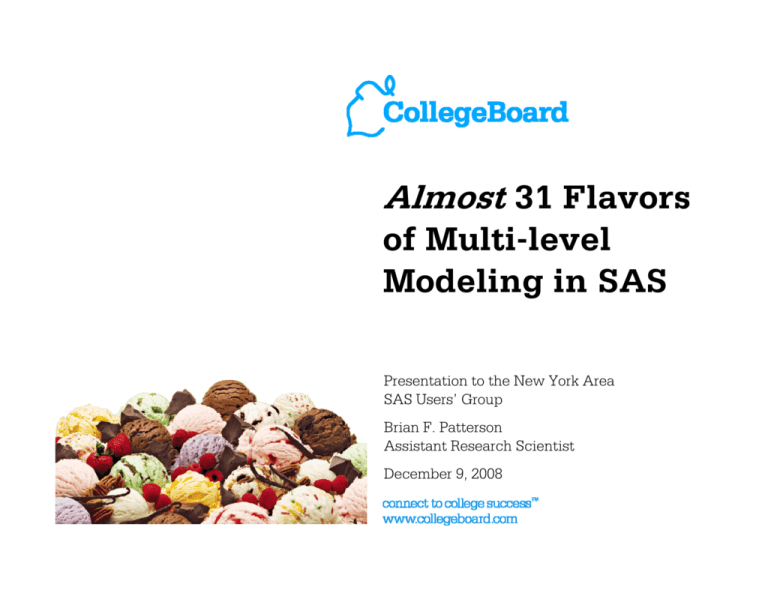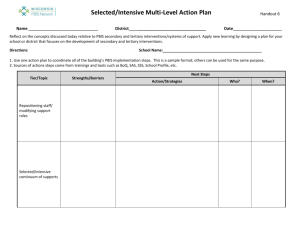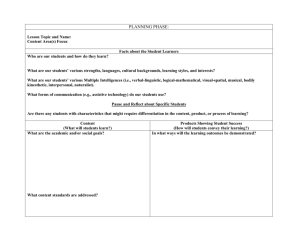Almost 31 Flavors of Multi-level Modeling in SAS - Research
advertisement

Almost 31 Flavors of Multi-level Modeling in SAS Presentation to the New York Area SAS Users’ Group Brian F. Patterson Assistant Research Scientist December 9, 2008 Overview 2 1. Introduction (10 min.) 2. Review e e o of Statistics Stat st cs ((10 0 min.)) 3. SAS for Multi-level Models (20 min.) 4. Research Using MMs (5 min.) 5 Question / Answer Period 5. (15 min.) min ) Multi-level, NYASUG, Dec. 2008 1.1 Introduction • Why multi-level models? • Avoid aggregation gg g bias and inflated std. err. • Disentangle group- and individual-level effects • Strengthen generalizability to group-level pop. • Model changes g over time 3 Multi-level, NYASUG, Dec. 2008 1.2 Definition of Terms • SAT • College g admissions test consisting g of Critical Reading, Math & Writing sections on 200-800 scale • Advanced Placement • High school program created to give students the opportunity to take college-level college level courses • Visit: http://www.collegeboard.com/ 4 Multi-level, NYASUG, Dec. 2008 1.3 Multi-level Modeling Opportunities • Model first-year grade point average (FYGPA) at 110 colleges and universities • Model prob. of participation in Advanced Placement Program® at many high schools • Model FYGPA with high-school- and college-variability with cross-classified data 5 Multi-level, NYASUG, Dec. 2008 1.4 SAS Requirements for Multi-level Modeling • Many observations • Large g sample p size within each group g p • Sufficient number of groups • Computing power • Procedures (and optional statements within some procedures) are memory-intensive 6 • Data D t structure t t Multi-level, NYASUG, Dec. 2008 1.5 Nested Data Structure in SAS 7 Multi-level, NYASUG, Dec. 2008 1.6 Repeated Measures Data in SAS 8 Multi-level, NYASUG, Dec. 2008 1.7 SAS Mixed Effects Procedures • Main procedures discussed: • PROC MIXED • PROC GLIMMIX (experimental in v9.1.3; v9.2) • Others Oh with i h mixed i d model d l capabilities: bili i • PROC GLM; PROC HPMIXED (v9.2); PROC LATTICE; PROC NESTED; PROC NLMIXED; PROC VARCOMP 9 Multi-level, NYASUG, Dec. 2008 2.1 From Linear to Multi-level Models • Multi-level models (MMs) as generalization of linear and generalized linear models • Assumption of independent error terms with PROC REG DATA= DATA_001; MODEL Y = X1-Xp; RUN; 10 PROC MIXED DATA= DATA_001; MODEL Y = X1-Xp; RUN; Multi-level, NYASUG, Dec. 2008 2.2 Null Multi-level Model • Two-level data; individuals within groups • Intercepts vary by group; no other pred. • Notation N t ti from f Raudenbush R d b h & Bryk B k (2001). (2001) Model Variance Components 11 SAS Code PROC MIXED DATA= DATA_001 COVTEST; MODEL Y = / SOLUTION; RANDOM INTERCEPT / SUBJECT= Group TYPE= VC; RUN; Multi-level, NYASUG, Dec. 2008 2.3 Null MM as a Single Equation • Substituting the expression for from the group-level into the individual-level equation: Residual Grand mean Group random effect 12 Multi-level, NYASUG, Dec. 2008 2.4 Graph of Null MM Individual variation about b t group mean 3.2 3.0 Y Group G variation about grand mean 2.8 2.6 2.4 2.2 2.0 1.8 1.6 14 1.4 1.2 0001 0002 0003 0004 0005 Group p Group 13 0001 0004 0003 0005 Multi-level, NYASUG, Dec. 2008 2.5 Do we Need a Multi-level Model? • Based on the null model (or an ANOVA table) we compute the intra-class correlation coef. (ICC) for linear models • Indicates the p proportion p of error variance in the outcome relative to overall error variance. 14 Multi-level, NYASUG, Dec. 2008 2.6 SAS Output: Null Model • ICC= 0.014 / 0.10 = 0.14 0 14 • ICC not meaningful for GLMM 15 • COVTEST option in PROC MIXED Multi-level, NYASUG, Dec. 2008 2.7 SAS Output: Null Model • Random intercept specified • No other predictors included in the model 16 Multi-level, NYASUG, Dec. 2008 3.1 MM with Level-1 Random Intercepts & Fixed Slopes • Intercepts vary by group; other predictors are fixed Model SAS Code Variance Components 17 PROC MIXED DATA= DATA_001 COVTEST; MODEL Y= Y X1 X1-Xp Xp / SOLUTION; RANDOM INTERCEPT / SUBJECT= Group TYPE= VC; RUN; Multi-level, NYASUG, Dec. 2008 3.2 Graph of MM with Level-1 Fixed X1 Slope 3.2 3.0 2.8 2.6 Y 2.4 2.2 2.0 1.8 1.6 1.4 1.2 0 1 2 3 4 5 X1 Group 18 0001 0004 0003 0005 Multi-level, NYASUG, Dec. 2008 3.3 Graph of Null MM 3.2 3.0 2.8 2.6 Y 2.4 2.2 2.0 1.8 16 1.6 1.4 1.2 0001 0002 0003 0004 0005 Group Group 19 0001 0004 0003 0005 Multi-level, NYASUG, Dec. 2008 3.4 SAS Output: Fixed Slopes • Same random effects as null • Slopes are constrained to be equal across groups 20 Multi-level, NYASUG, Dec. 2008 3.5 MM with Fixed- & RandomIntercept and Slope Effects • Intercepts and other parameters vary Model SAS Code Variance Components p 21 PROC MIXED DATA= DATA_001 COVTEST; MODEL Y= Y X1 X1-Xp Xp / SOLUTION; RANDOM INTERCEPT X1-Xp / SUBJECT= Group TYPE= VC; RUN; Multi-level, NYASUG, Dec. 2008 3.6 Graph of MM with Level-1 Fixed- and Random-Effects 4.0 3.8 3.6 3.4 Y 3.2 3.0 2.8 2.6 24 2.4 2.2 2.0 0 1 2 3 4 5 X1 Group 22 0001 0004 0003 0005 Multi-level, NYASUG, Dec. 2008 3.7 SAS Output: Random Slopes • Same random effects as null • Slope for X1 allowed to be vary across groups • Notice in CovParms table 23 Multi-level, NYASUG, Dec. 2008 3.8 Generalized Linear Multi-level Models • With a non-normal outcome, it may be appropriate to use a generalized linear multi-level model (GLMM) • PROC GLIMMIX will meet most needs;; PROC NLMIXED may be appropriate otherwise • Recall ICC not meaningful; rely on size and standard error of cov. parameter estimates 24 • Prediction sluggish in exp exp. GLIMMIX Multi-level, NYASUG, Dec. 2008 3.9 SAS Specification of GLMM PROC GLIMMIX DATA = Data_004 METHOD= RSPL INITGLM IC= PQ NAMELEN= 65 NOCLPRINT; CLASS Group_ID; Group ID; NLOPTIONS TECHNIQUE= NRRIDG; MODEL Event= Event X1-Xp X1 Xp / DIST DIST= BINARY LINK= LOGIT SOLUTION CL; RANDOM INTERCEPT / SUBJECT SUBJECT= Group Group_ID; ID; RUN; 25 Multi-level, NYASUG, Dec. 2008 3.10 PROC GLIMMIX for Propensity Score Matching • Add the following to our PROC GLIMMIX: OUTPUT OUT= Data_004_Pred PREDICTED(BLUP ILINK)= Treat_Prob_Pred STDERR(BLUP ILINK)= Treat_Prob_SE; 26 • Use the predicted probabilities to perform propensity score matching. matching Multi-level, NYASUG, Dec. 2008 3.11 Notes on Covariance Structure • Theory and subject matter expertise should dictate the covariance structure • For hierarchically structured data: • Generally G ll mostt restrictive t i ti (J parm.): ) TYPE= VC • Generally least restrictive (J2 parm.): TYPE= UN • Many other options; check OnlineDoc 27 Multi-level, NYASUG, Dec. 2008 3.12 What Can Go Wrong? • Convergence problems • PROC HPMIXED? Need SAS 9.2. • Another estimation method? • Fewer fixed- and random-effects? • Variance components not estimated • Consider modifying RANDOM statement. 28 Multi-level, NYASUG, Dec. 2008 3.13 What Else Can Go Wrong? • “Out of memory” Error • Some mixed p procedures are p prone to this error • “PROC MIXED is looking for a contiguous memory space and cannot find one large enough due to the relocation of the operating system y modules.” -SAS Problem Note 15060. • Solution: Try to defragment the target drive. 29 Multi-level, NYASUG, Dec. 2008 3.14 Diagnosing and Solving Problems • Diagnose what’s going wrong and when • Use the LOGNOTE option p on PROC MIXED for estimation progress step-by-step • Remove statements / options to find the issue • If convergence is a problem, consider reparameterizing the model • Especially in the case of generalized linear MMs 30 Multi-level, NYASUG, Dec. 2008 3.15 Example of LOGNOTE Output NOTE: Levelizing effects. NOTE: A linear combination of covariance parameters is confounded with the residual p NOTE P NOTE: Processing e i subject bje t and d group effects. effe t variance. NOTE: Setting up data. NOTE: Computing Cholesky root of crossproducts matrix. NOTE: Loading data. NOTE: Computing likelihood in iteration 0. NOTE: Computing H matrix. NOTE: Computing G derivatives in iteration 1. NOTE: Computing Type 3 sums of squares. p g likelihood in iteration 1. NOTE: Computing NOTE: Computing G derivatives in iteration 1. NOTE: Convergence criteria met but final positive definite. hessian is not p NOTE: PROCEDURE MIXED used ((Total process time): real time 0.35 seconds p time cpu 0.14 seconds NOTE: Computing likelihood in iteration 2. 31 Multi-level, NYASUG, Dec. 2008 4.1 Research & SAS Applications of Multi-level Models • Model first-year grade point average at 110 colleges and universities • Model probability participation in Advanced Placement Program® at many high schools • Model high-school- and college-variability in the effect of AP® participation 32 Multi-level, NYASUG, Dec. 2008 4.2 Model FYGPA Across 110 Colleges • Outcome: FYGPA, as normal continuous • Levels: student and college (nested) • Possible SAS Procedures: • PROC MIXED • PROC HPMIXED (new in 9 9.2) 2) • For large number of fixed- or random-effects 33 Multi-level, NYASUG, Dec. 2008 4.3 Model AP Participation Across Many High Schools • Outcome: Indicator of AP Participation • Levels: student and high school (nested) • High schools may be nested within districts • Possible SAS Procedures: • PROC GLIMMIX (9.2; (9 2; exp exp. in 9 9.1.3) 1 3) • PROC NLMIXED 34 Multi-level, NYASUG, Dec. 2008 4.4 Model Effect of AP® Participation across HS & Colleges • Outcome: FYGPA, as normal continuous • Levels: student student, high school and college • Data are cross-classified by HS and college • Possible SAS Procedures: • PROC MIXED • PROC HPMIXED (new in 9.2) 35 Multi-level, NYASUG, Dec. 2008 4.5 HS & College Cross-classified Data • Data are not strictly nested • Students from high g schools A,, B and C attend colleges I and II • Random effects: high school and college levels HS B HS A College g I 36 HS C College g II Multi-level, NYASUG, Dec. 2008 4.6 SAS Specification of CCMM PROC MIXED DATA = Data_002 COVTEST; CLASS HS_ID College_ID; MODEL Y= X1-Xp / SOLUTION CL; RANDOM INTERCEPT X1 / High School Random Effects SUBJECT= HS_ID; RANDOM INTERCEPT X1-Xp / SUBJECT= College_ID; RUN; 37 College C ll Random Effects Multi-level, NYASUG, Dec. 2008 4.7 Non-Educational Applications • Multi-site clinical trials • Patients strictlyy nested within sites or crossclassified across sites • Retail applications • PROC GLIMMIX to estimate same-store sales over quarterly observations 38 Multi-level, NYASUG, Dec. 2008 4.8 General References • Multi-level Modeling Texts: • Raudenbush,, S. W. and Bryk, y , A. S. 2002. Hierarchical Linear Models: Applications and Data Analysis Methods. Second Edition. • Snijders, T. A. B. and Bosker, R. J. 1999. Multilevel Analysis: y An Introduction to Basic and Advanced Multilevel Modeling. 39 Multi-level, NYASUG, Dec. 2008 4.9 SAS-Oriented Reference • Multi-level Modeling Articles for SAS: • Singer, g , J. D. 1998. “Using g SAS PROC MIXED to Fit Multilevel Models, Hierarchical Models, and Individual Growth Models.” Journal of Educational and Behavioral Statistics, Vol. 24, 323-355. 40 Multi-level, NYASUG, Dec. 2008 5.1 Question / Answer Period • Any questions? Statistical, SAS-oriented or otherwise? 41 Multi-level, NYASUG, Dec. 2008 Thank You • Thank you all very much for having me. • Special thanks to Martin Feuerman of NYASUG and Mary-Margaret Kerns of The College Board Board. 42 Multi-level, NYASUG, Dec. 2008 Contact Information Brian F. Patterson The College Board, Research & Development Assistant Research Scientist 212-713-7714 212 713 7714 bpatterson@collegeboard.org http://www.collegeboard.com/research 43 Multi-level, NYASUG, Dec. 2008





